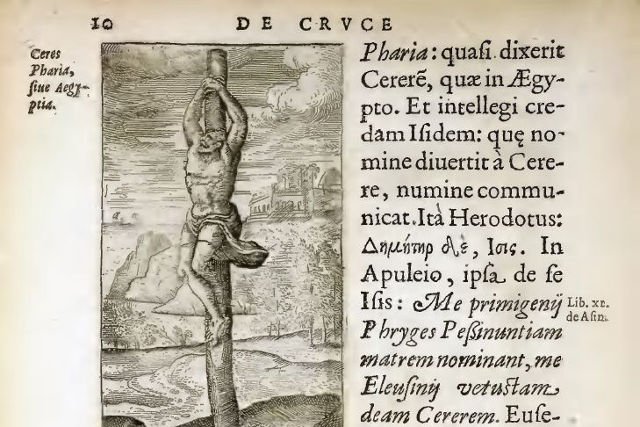PhilosopherJay wrote:Hi maryhelena,
...
I'm wondering if the point about "the first example of that punishment being inflicted on a king" is not related to the beheading but to what would have been the case if Antigonus had been hung alive on that cross/stake/pole/suspension instrument. i.e. its the fact that such a suspension was not a postmortem suspension but that the victim, Antigonus in this case, was hung up alive. That it was this, a Jewish King, or any King, hung up alive, that was the 'it never happened before' argument of the sources. Whereas beheading was 'normal', suspending alive a King on a cross/stake/pole was not.
On the Nahum Pesher of the DSS.
GUNNAR SAMUELSSON
Crucifixion in Antiquity
The mention of a victim being suspended alive on wood is evident. The
text echoes some apparently known event in the past (Alexander Jannaeus'
execution of the eight hundred Pharisees is commonly suggested).127
The text, labeled as a crucifixion account by Hengel, Kuhn and Chapman,
1 2 8 describes some kind of an ante-mortem suspension - but does not
reveal which kind. The event is mentionable by the author of the Pesher
since it is a violation of the Jewish tradition in Deuteronomy 21.22-23 - a
/?0s£-mortem suspension. The offense was that the wicked man suspended
men, in this case alive, not that he did it in a particular way (e.g., nailed
them with outstretched limbs on a cross-shaped execution tool). The reason
why the author of the Pesher stresses that they were alive while suspended
could be, as has been seen earlier, that the norm was a postmortem
suspension (coherent with Deut 21.22-23).
GUNNAR SAMUELSSON seems to have made quite a name for himself - and caused some disquite among some christians regarding JC probably not hung up on the standard christian cross. His webpage gives many media links regarding his book.
http://www.exegetics.org/Media.html
I've not read Samuelsson' book - just searched for a few words....
However, this is interesting:
Gospels don't say Jesus was crucified, scholar claims
Samuelson wants to be very clear about what he is saying and what he is not saying.
Most importantly, he says, he is not claiming Jesus was not crucified - only that the Gospels do not say he was.
http://religion.blogs.cnn.com/2010/07/0 ... ar-claims/
Interesting - so....the gospel JC suspended on a cross/stake/pole, tortured, scourged - did not die on that instrument of suspension - as that would defeat the purpose of such an instrument. The purpose being torture not execution of a live body. The crucifixion of dead bodies being to deny a normal burial - leaving the body to be ravished by the carrion birds. If this is so , then no wonder christians would be up in arms - but it might well throw some light on the fate of Antigonus...
Must read some more of this book - thanks PhilospherJay for mentioning it...

As of now:
Suspension = bodies dead or alive. However, Deut 21.22-23."When someone is convicted of a crime punishable by death and is executed, and you hang him on a tree, his corpse must not remain all night upon the tree; you shall bury him that same day, for anyone hung on a tree is under God’s curse. You must not defile the land that the Lord your God is giving you for possession". A postmortem suspension for a short while - thus 'saving' the body from the carrion birds and not defiling the land. Living bodies tortured.
Crucifixion = suspended dead bodies denied burial and left for food for the carrion birds. The final humiliation. The final humiliation of a crucifixion that Antigonus did not undergo.
I wonder what Ehrman, with his no tomb no decent burial argument, would make of all this...i.e. re Samuelson, it looks to be that 'crucifixion' relates to the suspension of
dead bodies that were to be denied a normal burial and left to the carrion birds.
-------------------
Bible doesn't say Jesus was crucified, scholar claims
He found very little evidence of crucifixion as a method of execution, though he did find corpses being suspended, people being hanged from trees, and more gruesome methods of execution such as impaling people by the belly or rectum.
The same Greek word was used to refer to all the different practices, he found.
That's what led him to doubt that the Gospels specify that Jesus was crucified.
At the time they were written, "there is no word in Greek, Latin, Aramaic or Hebrew that means crucifixion in the sense that we think of it," he says.
It's only after the death of Jesus - and because of the death of Jesus - that the Greek word "stauroun" comes specifically to mean executing a person on the cross, he argues.
http://www.thedominican.net/2010/07/bib ... t-say.html
[my bolding]


